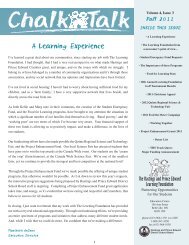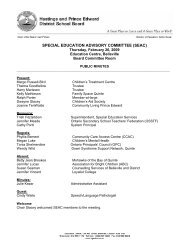Grade 11 Healthy Active Living Education Additional Supports ...
Grade 11 Healthy Active Living Education Additional Supports ...
Grade 11 Healthy Active Living Education Additional Supports ...
Create successful ePaper yourself
Turn your PDF publications into a flip-book with our unique Google optimized e-Paper software.
For contraception: Check for secretions after menses complete (it is unwise to have<br />
intercourse during menses as it is difficult to distinguish secretions from blood. You may<br />
have unprotected intercourse on pre-ovulatory days if no secretions are present. (Note:<br />
Be aware of risk of STIÕs with unprotected intercourse.) Do not confuse semen or arousal<br />
secretions for with cervical secretions. Cervical secretions first appear until four days past<br />
the last day of clear slippery secretion. You may have unprotected intercourse after this<br />
time until the first day of menses. During this time the mucus will be rubbery in<br />
consistency.<br />
For conception: The probability of conception is greatest when the cervical secretions<br />
are abundant, clear, sticky and stretchy.<br />
* Effectiveness: perfect use: 3%, typical use: 20%<br />
Calendar Method<br />
Keep a record of your cycles for at least 6 months. You cannot use the Pill or other<br />
hormones during this time. Count the first day of menstruation as day one. The last day of<br />
the cycle is the one just before the next period begins. Subtract 18 from your shortest<br />
cycle to get the first fertile day. Subtract <strong>11</strong> from your longest cycle to get the last fertile<br />
day. Avoid unprotected vaginal intercourse from the first fertile day up to and including<br />
the last fertile day. Continue recording the length of your cycles and use the shortest and<br />
longest of the 6 most recent cycles for your calculation.<br />
* Effectiveness: perfect use: probability of pregnancy 5%, typical use; 20%<br />
Resources for Understanding Reproductive Health<br />
Birth Control Handbook. Canada: Montreal Health Press Inc., 1999.<br />
Hatcher, R., J. Trussell, F. Stewart et al., Contraceptive Technology. New York: Ardent<br />
Media inc. 1998 ISBN 0-0664902-07<br />
Health Canada. CanadaÕs Food Guide to <strong>Healthy</strong> Eating. Ottawa: Minister of Public<br />
Works and Government Services Canada, 1997. ISBN 0-662-19648-1<br />
Call your local health unit for copies or access the Internet: www.hc.sc.gc.ca<br />
Health Canada. Food Guide Facts: Background for Educators and Communicators.<br />
Ottawa: Minister of Supply and Services, 1997. ISBN 0-662-19648-1<br />
Also available on the Internet: www.hc.sc.gc.ca<br />
Health Canada. Nutrition for a <strong>Healthy</strong> Pregnancy; National Guidelines for the<br />
Childbearing Years. Ottawa: Minister of Public Works and Govt. Services Canada, 1999.<br />
Also available on the Internet: www.hc.sc.gc.ca<br />
Nutrition Matters. Pregnant or Breastfeeding? Get the facts on herbal products and teas.<br />
Toronto Public Health, 2000.<br />
<strong>Grade</strong> <strong>11</strong> <strong>Healthy</strong> <strong>Active</strong> <strong>Living</strong> <strong>Education</strong> (PPL30), Module #1 <strong>Healthy</strong> Relationships and Sexuality<br />
Page 19
















